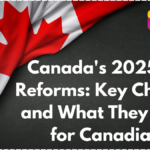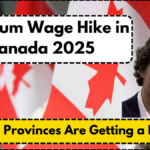As of May 2025, Canada is poised to undergo substantial updates to its minimum wage structures across multiple provinces. These changes are not merely symbolic responses to inflation; they mark a progressive effort to bridge the widening gap between income and cost of living. The rising expenses for essentials such as housing, transportation, and food have compelled provincial governments to rethink wage benchmarks, ensuring that all workers can sustain a decent standard of living.

Provinces Taking the Lead in Wage Reform
Ontario, British Columbia, and Alberta are at the forefront of this movement. Each province has adopted a unique strategy to tackle local economic conditions and workforce dynamics:
- Ontario is preparing for a significant wage hike aimed at increasing financial stability for thousands of low-income workers. The provincial government has focused on industries where wage inequality is most severe.
- British Columbia is targeting wage increases particularly in sectors like hospitality and retail. These sectors employ a large percentage of minimum wage workers and have been disproportionately affected by inflation.
- Alberta plans to introduce incremental increases, especially for physically demanding jobs that often go underpaid. This includes workers in sectors such as agriculture, manufacturing, and custodial services.
Why Wage Increases Matter in 2025
These reforms are about more than just monetary adjustments. They reflect a serious commitment to correcting wage disparities and promoting economic inclusion. With inflation continuing to pressure household budgets, increasing the minimum wage is a proactive solution aimed at helping workers afford basic necessities.
The goal is to create a more balanced economy in which everyone has the opportunity to thrive—not just survive. By aligning wages more closely with real-world living expenses, provincial leaders are working to narrow the gap between the wealthy and the working class.
Positive Impact on Workers and the Broader Economy
Raising the minimum wage is expected to deliver widespread benefits:
- Workers will gain more disposable income, allowing them to better meet daily needs and potentially invest in long-term goals like education or home ownership.
- Employers may face increased labor costs, but they can also expect lower turnover, improved morale, and higher productivity as a result of a more financially secure workforce.
- Communities could experience a surge in economic activity as more individuals have money to spend on local goods and services.
Driving Economic Growth Through Consumer Spending
One of the most significant advantages of a higher minimum wage is its role in stimulating the economy. When workers earn more, they tend to spend more. This increased consumer spending can boost business revenue, foster expansion, and generate new job opportunities, especially in small- to mid-sized businesses that rely on local clientele.
Timelines and Implementation Schedules by Province
While the intent to raise the minimum wage is shared nationally, implementation will vary:
| Province | Planned Increase Date | Key Focus Sectors |
|---|---|---|
| Ontario | June 2025 | Service, Retail, Manufacturing |
| British Columbia | May 2025 | Hospitality, Retail |
| Alberta | July 2025 | Agriculture, Labor-Intensive |
Employers are being encouraged to prepare payroll systems ahead of these deadlines. Workers should monitor announcements from provincial labor ministries to stay updated on when their new wage will take effect.
Staying Proactive: Responsibilities for Employers and Workers
Awareness and preparation are critical during this transition. Workers should clarify when their new wages begin and confirm that they are being correctly compensated. Employers, on the other hand, must ensure legal compliance through timely system updates, transparent communication, and support for HR departments.
Clear documentation, updated contracts, and accessible communication channels can all ease this period of change and ensure a smooth adaptation for all parties involved.
Reimagining the Standard for Livable Wages
Beyond economic considerations, these wage hikes are a step toward recognizing the dignity of labor. In 2025, livable wages are no longer a lofty goal but a necessary foundation for equitable growth. Minimum wage earners are often among the most vulnerable, and ensuring their financial well-being is key to building a stronger, more inclusive economy.
By proactively addressing income disparities, Canada is taking decisive steps toward creating a fairer labor market.
Final Thoughts: What This Means for Canada in 2025
As Canada progresses through 2025, the nationwide initiative to increase minimum wages is a pivotal moment in labor policy. These changes are designed to create more economic opportunity, improve quality of life, and support a more engaged, stable workforce. Though implementation varies by province, the overarching goal remains the same: ensuring that all workers are equipped to meet life’s challenges with financial dignity and security.
Frequently Asked Questions (FAQ)
What is the minimum wage increase in Ontario for 2025?
Ontario plans to raise its minimum wage by mid-2025, with final figures expected to reflect cost-of-living adjustments and sector-specific needs.
How will employers be affected by the wage changes?
While employers might face higher payroll costs, they could benefit from improved employee morale, productivity, and retention, which may offset the initial financial burden.
Will every province raise the minimum wage in 2025?
Not all provinces have confirmed increases, but several—including Ontario, British Columbia, and Alberta—are moving ahead with reforms. Other regions may follow depending on economic conditions.
How should workers prepare for the upcoming changes?
Workers should stay updated via provincial announcements, verify changes on their pay stubs, and ask their employers about how the new wage rates will apply to their roles.
What sectors are most impacted by these wage increases?
Industries such as retail, hospitality, agriculture, and manual labor are expected to be most affected, as they typically employ a large share of minimum wage earners.
For More Information Click Here
Pari is a passionate writer known for captivating stories that blend imagination and reality. Inspired by travel, history, and everyday moments, Pari crafts narratives that resonate deeply with readers.




